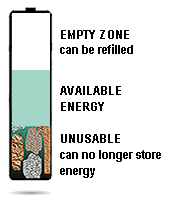<< Previous page INDEX Next page >>
6. The Secrets of Battery Runtime
Is the runtime of a portable device directly related to the size of the battery and the energy it can hold? In most cases, the answer is yes. But with digital equipment, the length of time a battery can operate is not necessarily linear to the amount of energy stored in the battery.
In this chapter we examine why the specified runtime of a portable device cannot always be achieved, especially after the battery has aged. We address the four renegades that are affecting the performance of the battery. They are: declining capacity, increasing internal resistance, elevated self-discharge, and premature voltage cut-off on discharge.
6.1 Declining Capacity
The amount of charge a battery can hold gradually decreases due to usage, aging and, with some chemistries, lack of maintenance. Specified to deliver about 100 percent capacity when new, the battery eventually requires replacement when the capacity drops to the 70 or 60 percent level. The warranty threshold is typically 80 percent.
The energy storage of a battery can be divided into three imaginary sections consisting of available energy, the empty zone that can be refilled and the rock content that has become unusable. Figure 6-1 illustrates these three sections of a battery.
In nickel-based batteries, the rock content may be in the form of crystalline formation, also known as memory. Deep cycling can often restore the capacity to full service. Also known as ‘exercise’, a typical cycle consists of one or several discharges to 1V/cell with subsequent discharges.
Figure 6-1: Battery charge capacity.
Three imaginary sections of a battery consisting of available energy, empty zone and rock content.
With usage and age, the rock content grows. Without regular maintenance, the user may end up carrying rocks instead of batteries.The loss of charge acceptance of the Li-ion/polymer batteries is due to cell oxidation, which occurs naturally during use and as part of aging. Li-ion batteries cannot be restored with cycling or any other external means. The capacity loss is permanent because the metals used in the cells are designated to run for a specific time only and are being consumed during their service life.
Performance degradation of the lead acid battery is often caused by sulfation, a thin layer that forms on the negative cell plates, which inhibits current flow. In addition, there is grid corrosion that sets in on the positive plate. With sealed lead acid batteries, the issue of water permeation, or loss of electrolyte, also comes into play. Sulfation can be reversed to a certain point with cycling and/or topping charge but corrosion and permeation are permanent. Adding water to a sealed lead acid battery may help to restore operation but the long-term results are unpredictable.
